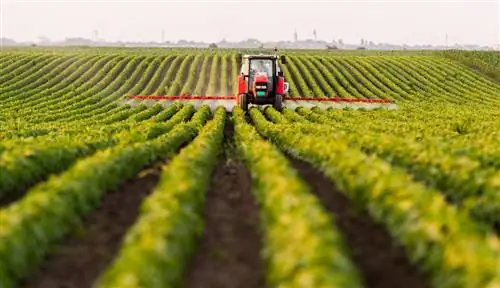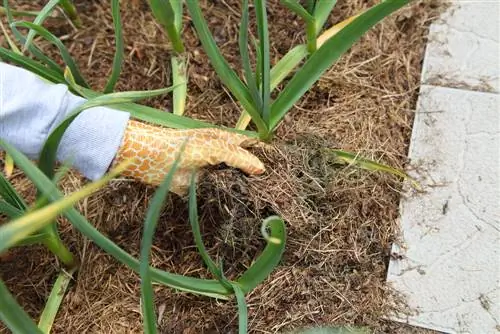- Author admin [email protected].
- Public 2023-12-16 16:46.
- Last modified 2025-01-23 11:22.
Monoculture is a form of farming that developed thousands of years ago. When the land was exhausted, people moved on. Today this is no longer possible, which is why other solutions are necessary. But the world has become dependent.
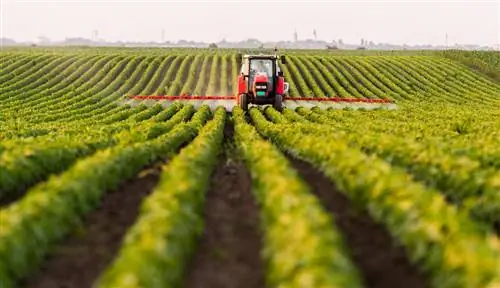
What does monoculture mean and what consequences does it have?
Monoculture refers to the cultivation of a single type of plant on an area over several years, which is practiced in agriculture, forestry and horticulture. Although this allows for simplified maintenance and high yields, monocultures are more susceptible to pests, diseases and soil nutrient depletion.
What does monoculture mean?
Monoculture is derived from the Greek terms monos for “alone” and cultura for “cultivation” or “care”. It refers to cultivation in which a crop species is grown on an area over several years. This form of cultivation, also known as pure culture, is used in agriculture and forestry as well as in horticulture. The advantages of this method are simplified care and high yields.

Crop rotation, mixed culture or monoculture?
The opposite of monoculture is mixed culture. This form of cultivation is also known as mixed crop rotation, because according to its definition, different crops are grown on an area at the same time and one after the other. Although the maintenance effort and harvest logistics are significantly higher than in monocultures, mixed cultivation is intended to compensate for the disadvantages of pure cultivation.
Advantages of mixed culture:
- Synergy: Plants protect each other from pests or provide nutrients
- Shading: higher growing plants ensure a moist microclimate in the lower area through leaf mass
- Protection: Soil is continuously protected from erosion by wind and rain
- Hedging: a total crop failure is avoided
Crop rotation is another opposite of monoculture, in which an area is cultivated with rotating crops. Attention is paid to ensuring the greatest possible versatility. Crop species that are not compatible with each other are grown separately in time and space. While crop rotation can be seen as a field economy, monoculture is a single-field economy. Typical plants for crop rotations are rapeseed, beets and potatoes. With these crops, the pest pressure in the pure culture is too high and the harvest can no longer be secured.
Does monoculture have disadvantages?
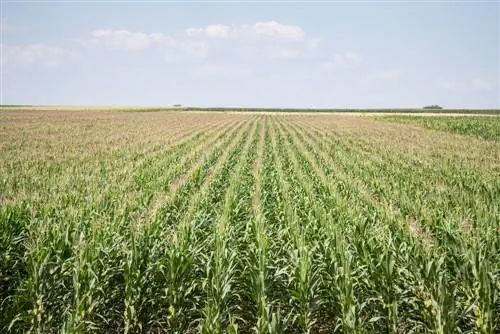
Monocultures are completely unnatural and very susceptible to diseases and pests
The fact that pure economics is still practiced lies in its advantages. This form does not require a fleet of different special machines, but the same machines can always be used. This routine also extends to marketing structures. Special knowledge in the field of a cultivated crop is sufficient to achieve the greatest possible harvest yield.
Negative side of pure culture:
- no optimal use of light and water
- Synergy effects do not come into play
- increased susceptibility to pests and diseases
- Soil experiences one-sided nutrient depletion
- more fertilizers and pesticides required
Monoculture in the forest
Nature strives for mixed cultures. No natural forest is home to just one type of plant; rather, it is a mosaic of coordinated organisms. Numerous animal species find a habitat in this ecosystem. Mixed forests have a mitigating effect on climate change because they store carbon dioxide over a longer period of time. This diverse space makes sense not only from an ecological perspective.
Nevertheless, numerous forests are characterized by monocultures. Spruces and other fast-growing coniferous trees are still cultivated in their pure form today. They ensure an optimal supply of the raw material wood to paper industries and wood processing plants.
Problems from the past:
- massive damage caused by wind breaks in 2007 and 2018
- extreme spread of the bark beetle from 2016 to 2019
- increasing acidification of the soil due to needles, so that liming has to be carried out
Background
Monocultures do not bring the desired profit
Studies by the University of Freiburg and the German Center for Integrative Biodiversity Research have shown that mixed cultures are more productive than pure cultures. Mixed stands with five different species produce around 50 percent more wood than monocultures. This aspect is based on improved synergy effects. The trees that grow at different heights are optimally supplied with light. Different root systems ensure improved use of the available nutrients. Mixed crops prove to be more resistant to pests and cope better with dry years.
Example Germany

Monocultures were also preferred in forestry for a long time
Spruce would not naturally occur in the current locations of spruce forests. It is a type of tree that only occurs naturally at altitudes of 500 meters and forms species-rich, patchy forests. Instead, the locations of the spruce forests would be characterized by mixed forests with a high proportion of beech trees.
Due to the numerous problems and increasing soil degradation, modern forestry is increasingly moving towards converting pure crops into site-compatible mixed crops. In the last few decades, the number of deciduous trees has increased by seven percent and the proportion of conifers has fallen by four percent. Today, deciduous trees make up about 43 percent of the wood floor.
Rainforest
In order to meet the high demand for palm oil, a strict monoculture is practiced in the tropical rainforests of Malaysia and Borneo. On these areas, oil palms stand in rows next to each other. Numerous animal and plant species are losing their habitat. But the negative consequences for these ecosystems are already becoming apparent during the preparations for cultivation.
Valuable rainforest areas are increasingly being cleared by fire. This measure releases large quantities of greenhouse gases and the soil then has to be prepared with artificial fertilizers and pesticides. The extreme rainfall in the tropics ensures that chemical substances are washed out of the ground and washed into the waterways. This also pollutes surrounding ecosystems.
Using alternative vegetable oils worsens the problem of rainforest destruction. It is more important that no more rainforest is converted into new plantations.
Monoculture in agriculture

In Asian there are soy fields that stretch to the horizon
Modern farms have specialized in growing a few crops. This form of farming appears to be more attractive for many farmers because they unite in cooperatives and increase efficiency through joint marketing strategies. The limited availability of arable land and the high demand for certain products favor monocultures.
| Typical growing areas | Method | Impact | Problems | |
|---|---|---|---|---|
| Soy | Asia, South America | large-scale forest clearance | Species diversity is declining | increased demand promotes use of genetically modified plants |
| Bananas | South America, India | Slash and burn of tropical rainforests | Habitat destruction, relocation of villages | Fungal disease destroys stocks worldwide |
| Corn | Germany | Cultivation on arable land and meadows | Mainization of the landscape | increasing butterfly deaths |
| Cotton | USA, India, China | Cultivation on agricultural land, additional areas through forest clearance | increased demand leads to production intensification | extreme water loss |
Consequences of pure agricultural culture
If the same plant species are grown over and over again in an area, pests and pathogens find better living conditions. The plants are increasingly prone to root infections. They can no longer optimally absorb nutrients from the soil, so their growth is negatively affected. This encourages the emergence of weeds, many of which are difficult to control. Farmers must respond to these phenomena. They use pesticides to control pests and kill weeds. To ensure that crops grow better, additional fertilizers are applied.
A look into history
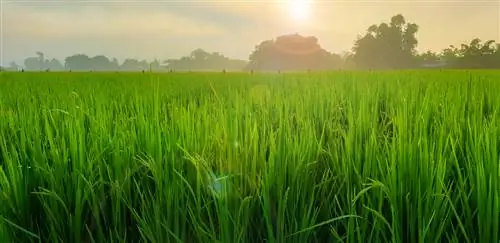
You need a lot of water to grow rice
From a historical perspective, wet rice cultivation in Asia is the most widespread form of agricultural monoculture. From a biology perspective, rice is not actually an aquatic plant. But around 3,000 B. C. Around 400 BC, people realized that this farming method suppressed pests and weeds. Through breeding over centuries, rice has developed into a water-tolerant plant. The roots form a special ventilation system so that the plants can cope with higher water levels.
Problems
To produce one kilogram of rice, between 3,000 and 5,000 liters of water are required. Due to the massive impact on the groundwater table, wet rice cultivation is banned in the areas surrounding Beijing. Algae formation increases in stagnant water. Therefore, the water in the plantations must be constantly moving.
Too high flow speeds cause soil erosion. The constant flooding of the fields creates an oxygen-free environment in the soil. Organisms live here that produce methane as part of metabolic processes. About 25 percent of global methane production comes from wet rice cultivation.
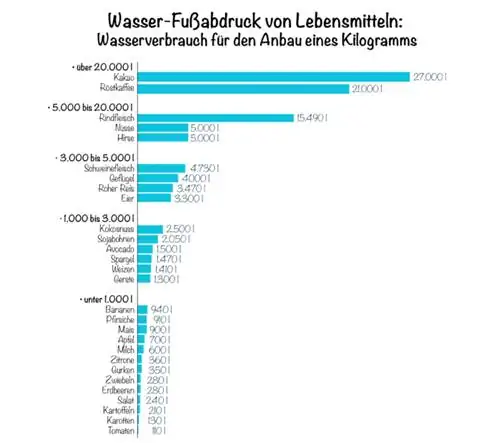
Monoculture in your own garden
Pure culture is common practice in the home garden. Often only one type of plant is planted on a bed. In the worst case, potatoes grow in the same place for many years. This means that garden owners expect less maintenance effort because the bed is harvested at one point in the year. It is enough to acquire specialized knowledge about this plant and a few devices enable the greatest possible efficiency when working. However, the basic principle of a natural garden is mixed culture.
More quality through mixed culture:
- various plant species ensure a natural balance
- Pests and beneficial insects keep each other in check
- Flower splendor spans different seasons
Companion plants in the bed
Take a closer look at the supposed weeds on the potato patch. Many of them have valuable uses and ensure that the bed is transformed into a functioning ecosystem. Flowering plants attract butterflies or insects whose caterpillars feed on harmful insects. Intensively scented herbs scare away pests with their essential oils. Legumes act as a natural fertilizer because they bind atmospheric nitrogen in the soil.
Tip
Pay particular attention to chickweed, clover or nettles. These plants improve the bed habitat and are also edible.
Thoughtful combinations
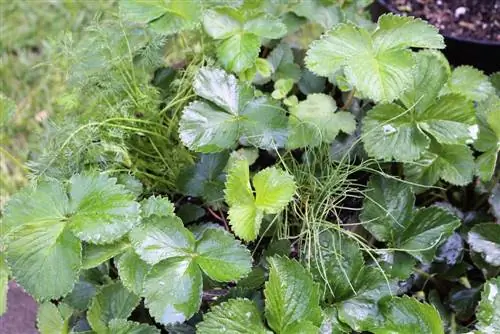
Strawberries and chives are ideal plant neighbors
Strawberries thrive better in the neighborhood of chives. This herb is rich in essential oils that prevent gray mold on strawberries. Borage ensures better pollination of flowers because the flowers attract wild bees, bumblebees and insects.
The deep-rooted chard goes perfectly with radicchio, radishes or chervil. These plants meet their water needs from the upper layers of the soil. If you don't feel like separating carrots after sowing, you should mix the seeds with black cumin and chamomile seeds. The coarse seeds ensure that the root vegetables are not sown too densely.
Tip
Design a mixed culture table. This way you can keep an overview all year round and can cultivate effective crop rotations.
Frequently asked questions
What are the economic risks of a monoculture?
If a farm engages in monoculture, it becomes heavily dependent on the market and prevailing prices. On the one hand, foregoing the cultivation of additional crops can bring in a high return. If unforeseeable disasters occur, in the worst case scenario economic bankruptcy will occur. At the national level, the range of agriculturally produced products is being severely reduced. Many countries depend on the demand for a product. They achieve large overall export shares with products that originate from monocultures:
- Mauritius: Sugar and rum make up up to 90 percent
- Cuba: generates up to 83 percent from cane sugar
- Ghana: Cocoa accounts for 76 percent
- Colombia: 66 percent of all export revenue comes from coffee
What are the ecological consequences of pure culture?
One-sided cultivation negatively affects the soil fauna and humus content. The soil's nutrient balance becomes unbalanced and weeds, pests and pathogens find optimal living conditions. Even before the harvest begins, pests can destroy up to 50 percent of the yield. In a monotonous plant population, the diversity of animals decreases, so that the natural opponents of pest insects are missing. Monocultures lead to increased soil erosion.
Where are monocultures typical?
In Central Europe, monocultures are dominant for wine and fruit growing businesses or purely grassland businesses. Germany is dominated by pure crops in areas where large-scale land consolidation has been carried out. In agricultural areas, pure corn, rapeseed or grain crops are common. In recent decades, the trend in forestry has increasingly been towards mixed forms.
What are the basic considerations of a mixed culture?
It doesn't make sense to plant crops from one family in the immediate vicinity. The plants are often affected by the same pests and diseases. With this variant, which falls under the mixed culture form of cultivation, the positive aspects cannot develop. The more diverse the plants are, the more optimal the distribution of tasks is and the better the ecosystem develops. Shallow-rooted and taprooted plants make optimal use of the resources in a bed because their root systems are active in different soil horizons.
Which mixed cultures have proven successful?
The Maya already grew pumpkins in the immediate vicinity of corn and beans. But cabbage also proves to be a good substitute for pumpkin in this mixture. Lentils thrive in a grain bed because they find good climbing support here. Carrots benefit from being surrounded by onions because they prevent pests. Different types of leaf and pickled lettuce also get along well together.

